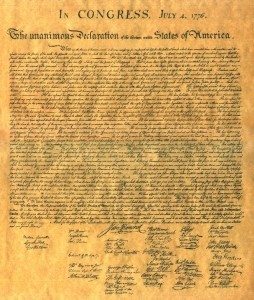Our Printed Past and Future
Celebrating July 4, it got me thinking about a delicate sheet of paper that means to many things to so many people, in the United States and beyond. What would happen if the Declaration of Indpendence had been printed today?
In the eighteen century the Declaration of Independence was drafted by the Founding Fathers. The manuscript went through several revisions as Thomas Jefferson asked for input from Benjamin Franklin, John Adams, and others in the Continental Congress
Congress ordered a broadside to be printed on a single sheet.
The initial printing came to be known as the Dunlap Broadside (after the Irish immigrant printer who set the type and stayed up through the night.)
A printed version was available on July 4, 1776.
It took at least another month to circulate the Declaration for signatures. Of the original 200 prints, approximately 25 still exist in libraries around the world (which is pretty incredible!).
These were distributed throughout the colonies!
- They were meant to be read to the population
- In some cases it was posted in public places
- General Washington read it to his troops!
- newspapers reprinted it in their publications
In a matter of mere months, most of the population was aware the nation had formed its own union, separate from Britain.
How would that happen TODAY, in the 21st century?
Jefferson would have used a collaboration site to post and review the document with authorized editors. Of course, using a file format that would track changes.
When the authors settled on the final version, it would be saved in a locked file format so that no alterations could be made. It would distributed to the entire Continental Congress for review and comment (perhaps through a ‘broadcast’ email list).
Signatures would be added digitally signifying agreement and the signed document would be saved in a final format (unalterable PDF?).
Simultaneously the Declaration would be released on social media of course, setting the Twitterverse abuzz, frenetic Facebook shares, a gaggle of Gawkers, Instagram
Potential hashtags? #declarethis #1776 #yourindependence – OK, I’ll stop there!
Digital media outlets would pick it up immediately (perhaps with a well-timed press release and email blast, using cross media – you’ want to know who was interested, right?
Broadcast and print media would take care of seeing to it that the information sped around the globe in the daily business cycle of international news.
All over the globe, people would be commenting on the Declaration in the blogosphere,
media posts, etc. At the end of the day, perhaps some readers would download the file . . . and maybe even some would print it!
It’s fun to think about – hope you enjoyed the 4th of July holiday!
Would you have shared the Declaration of Independence if it came across your twitter feed? Or your Facebook wall?









